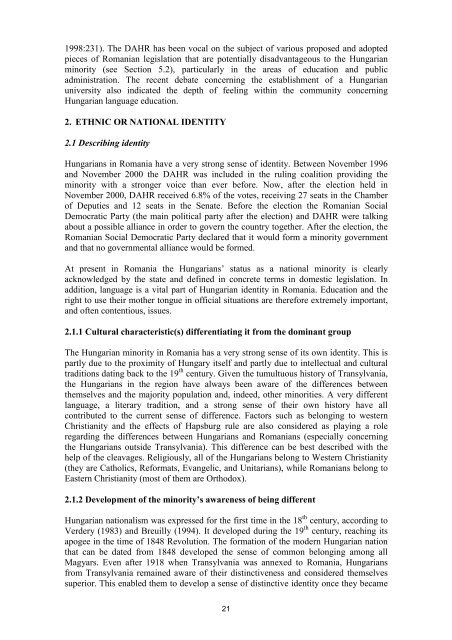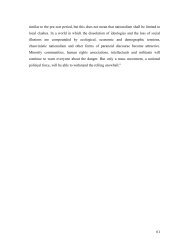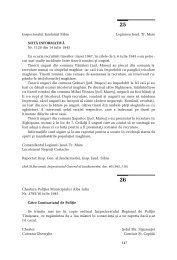Southeast Europe
Southeast Europe
Southeast Europe
Create successful ePaper yourself
Turn your PDF publications into a flip-book with our unique Google optimized e-Paper software.
1998:231). The DAHR has been vocal on the subject of various proposed and adopted<br />
pieces of Romanian legislation that are potentially disadvantageous to the Hungarian<br />
minority (see Section 5.2), particularly in the areas of education and public<br />
administration. The recent debate concerning the establishment of a Hungarian<br />
university also indicated the depth of feeling within the community concerning<br />
Hungarian language education.<br />
2. ETHNIC OR NATIONAL IDENTITY<br />
2.1 Describing identity<br />
Hungarians in Romania have a very strong sense of identity. Between November 1996<br />
and November 2000 the DAHR was included in the ruling coalition providing the<br />
minority with a stronger voice than ever before. Now, after the election held in<br />
November 2000, DAHR received 6.8% of the votes, receiving 27 seats in the Chamber<br />
of Deputies and 12 seats in the Senate. Before the election the Romanian Social<br />
Democratic Party (the main political party after the election) and DAHR were talking<br />
about a possible alliance in order to govern the country together. After the election, the<br />
Romanian Social Democratic Party declared that it would form a minority government<br />
and that no governmental alliance would be formed.<br />
At present in Romania the Hungarians’ status as a national minority is clearly<br />
acknowledged by the state and defined in concrete terms in domestic legislation. In<br />
addition, language is a vital part of Hungarian identity in Romania. Education and the<br />
right to use their mother tongue in official situations are therefore extremely important,<br />
and often contentious, issues.<br />
2.1.1 Cultural characteristic(s) differentiating it from the dominant group<br />
The Hungarian minority in Romania has a very strong sense of its own identity. This is<br />
partly due to the proximity of Hungary itself and partly due to intellectual and cultural<br />
traditions dating back to the 19 th century. Given the tumultuous history of Transylvania,<br />
the Hungarians in the region have always been aware of the differences between<br />
themselves and the majority population and, indeed, other minorities. A very different<br />
language, a literary tradition, and a strong sense of their own history have all<br />
contributed to the current sense of difference. Factors such as belonging to western<br />
Christianity and the effects of Hapsburg rule are also considered as playing a role<br />
regarding the differences between Hungarians and Romanians (especially concerning<br />
the Hungarians outside Transylvania). This difference can be best described with the<br />
help of the cleavages. Religiously, all of the Hungarians belong to Western Christianity<br />
(they are Catholics, Reformats, Evangelic, and Unitarians), while Romanians belong to<br />
Eastern Christianity (most of them are Orthodox).<br />
2.1.2 Development of the minority’s awareness of being different<br />
Hungarian nationalism was expressed for the first time in the 18 th century, according to<br />
Verdery (1983) and Breuilly (1994). It developed during the 19 th century, reaching its<br />
apogee in the time of 1848 Revolution. The formation of the modern Hungarian nation<br />
that can be dated from 1848 developed the sense of common belonging among all<br />
Magyars. Even after 1918 when Transylvania was annexed to Romania, Hungarians<br />
from Transylvania remained aware of their distinctiveness and considered themselves<br />
superior. This enabled them to develop a sense of distinctive identity once they became<br />
21









